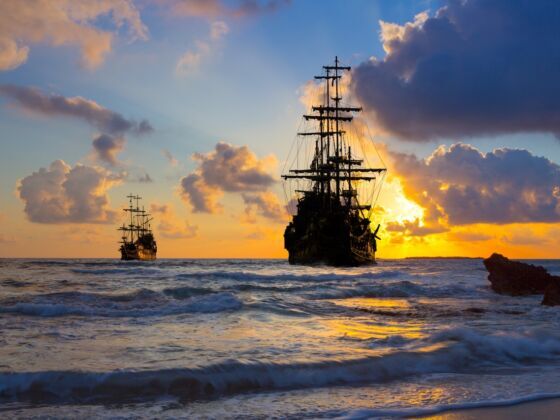Melaka’s Malay Sultanate Water Wheel
Strait of Malacca. This is the thin body of water separating peninsular Malaysia from the Indonesian island of Sumatra. As part of the main shipping channel between the Indian and Pacific Oceans, it has always attracted a heavy pirate presence, from the days of Arabian maritime traders to modern times.
Cabo Rojo, Puerto Rico
Puerto Rico. Roberto Cofresi, “Puerto Rico‘s pirate,” built a career out of plundering Spanish and American ships carrying gold and other precious cargo in the early 1800s. He was born in Cabo Rojo (pictured above), where there’s now a statue of him.
La Marsa beach
Barbary Coast. From the 16th to 19th centuries, the North Coast of Africa was the domain of the Barbary Corsairs, who home-ported in cities like Tunis, above. They terrorized coastal settlements all over the Mediterranean and down West Africa, capturing people to sell into slavery.
Madagascar palms
Madagascar. With the rise of the Southeast Asian spice trade, European ships became frequent visitors to the Indian Ocean and Africa’s east coast. Madagascar was the perfect place to stage an ambush. In particular, Sainte-Marie, a small island just northeast of the main landmass, was overrun with pirates.
Sulawesi mist
South Sulawesi. Another great spot to take advantage of spice traders was this island in the middle of the Indonesian archipelago. Pirates still operate in the nearby Celebes Sea, though they don’t make international headlines like the Somalis.
Pirate ship, Nassau, New Providence, Bahamas
New Providence, Bahamas. Plenty of Spanish ships, floating home with all that silver they were pulling out of the Andes, were picked off by pirates based out of this island, now the most populous in the Bahamas.
Jolo
Jolo. On the other side of the Celebes Sea from Sulawesi, this was another island from which pirates ran raids in the age of the spice trade. These days, it’s better known for its Islamist resistance to the central government of the Philippines.
Pirate graffiti, Cuba
Cuba. Cuba has lots of experience with pirates: they used the marshy inlets along the south coast to hide out, and also attacked the island’s main population centers on a regular basis.
Xiamen: Gulangyu Island
South China Coast. After her husband built up a coalition of pirate ships large enough to rival the Qing navy, Ching Shih took control and raided cities all along the south coast. She eventually received amnesty from the government and was allowed to keep all her loot and live the rest of her life in comfort.
Saint Malo from the sea
Saint-Malo, France. The corsairs that hung out on the coast of Brittany were authorized to extract tribute from English ships passing through the Channel, but they also ventured further out on raids.
Port Royal
Port Royal, Jamaica. After busy campaigns attacking and looting big-empire ships (mostly Spanish), northern Caribbean pirates often headed to Port Royal to sell or spend their captured booty.
Ships at low tide in Bombay
Mumbai, India. Kanhoji Angre planned his maritime attacks from islands around what was then known as Bombay. Although he was considered a pirate by his Western victims, he could also be called a freedom fighter against the colonizing powers fighting for control over India. He was never defeated.
